Baioloji

Baioloji bi di saientifik stodi of laif.[1][2][3] E bi a natural saiens with a brod skop but get several unifaiyin themes wey tai am togeda as a singul, coherent fild.[1][2][3] For instans, all oganisims dey made up of cells wey dey proces hereditari infomashon wey dey enkoded for jeens, wey fit dey transmited to fucho jenerashions. Anoda major theme bi evolushion, wey dey explain di uniti and daivasiti of laif.[1][2][3] Eneji procesin also dey impotant to laif as e dey allow oganisims to muv, grow, and riprodius.[1][2][3] Fainali, all oganisims dey abul to regulaet their own intanal envaironments.[1][2][3][4][5]
Baiolojists dey abul to stodi laif at multipul levuls of oganaizashon,[1] from di molekula baioloji of a cell to di anatomi and fisioloji of plants and animals, and evolushon of populashions.[1][6] Hence, multipul subdisiplins within baioloji, each defaind bai di nacho of their risearch questions and di tulz wey dey involvd.[7][8][9] Laik oda saientists, baiolojists dey yuz di saientifik method to mek obsavashons, poz questions, jeneraet hypotheses, perform experiments, and fom konklushons abaut di wold araund dem.[1]
Laif for Earth, wey emej moh than 3.7 billion years ago,[10] dey immensli daivas. Baiolojists don seek to stodi and klasifai di various foms of laif, from prokaryotik oganisims such as achaea and bakteria to eukaryotik oganisims such as protists, fungai, plants, and animals. These various oganisims kontriboot to di baiodaivasiti of ekosystems, whe dem dey play speshialaizd rols for di caikulin of nutrients and eneji thru their baiofysikal envaironment.
Also si
[chenj-am | chenj-am for orijin]Referens
[chenj-am | chenj-am for orijin]- ↑ 1.0 1.1 1.2 1.3 1.4 1.5 1.6 1.7 Urry, Lisa; Cain, Michael; Wasserman, Steven; Minorsky, Peter; Reece, Jane (2017). "Evolushion, di themes of baioloji, and saientifik inquaiari". Kampbell Baioloji (11th ed.). Niu Yok: Pearson. pp. 2–26. ISBN 978-0134093413.
- ↑ 2.0 2.1 2.2 2.3 2.4 Hillis, David M.; Heller, H. Craig; Hacker, Sally D.; Laskowski, Marta J.; Sadava, David E. (2020). "Stodiyin laif". Laif: Di Saiens of Baioloji (12th ed.). W. H. Freeman. ISBN 978-1319017644.
- ↑ 3.0 3.1 3.2 3.3 3.4 Freeman, Scott; Quillin, Kim; Allison, Lizabeth; Blak, Maikel; Podgorski, Greg; Taylor, Emily; Karmikael, Jeff (2017). "Baioloji and di tri of laif". Baiolojikal Saiens (6th ed.). Hoboken, N.J.: Pearson. pp. 1–18. ISBN 978-0321976499.
- ↑ Modell, Harold; Kliff, William; Maikel, Joel; McFarland, Jenny; Wenderoth, Mary Pat; Wright, Ann (December 2015). "A fisiolojist's viu of homostasis". Advansis for Fisioloji Edukayshon. 39 (4): 259–266. doi:10.1152/advan.00107.2015. PMC 4669363. PMID 26628646.
- ↑ Davies, PC; Rieper, E; Tuszynski, JA (January 2013). "Self-oganaizashon and entropi redukshon for a livin cell". Bio Systems. 111 (1): 1–10. doi:10.1016/j.biosystems.2012.10.005. PMC 3712629. PMID 23159919.
- ↑ Bayzd on definishon from: "Aquarena Wetlands Projekt glossari of tems". Texas State University at San Marcos. Archived from the original on 2004-06-08.
- ↑ Craig, Nancy (2014). Molekula Baioloji, Prinsipuls of Genome Funkshon. OUP Oxford. ISBN 978-0-19-965857-2.
- ↑ Mosconi, Francesco; Julou, Thomas; Desprat, Nicolas; Sinha, Deepak Kumar; Allemand, Jean-François; Vincent Croquette; Bensimon, David (2008). "Som nonlinia chalenjis for baioloji". Nonliniariti. 21 (8): T131. Bibcode:2008Nonli..21..131M. doi:10.1088/0951-7715/21/8/T03. S2CID 119808230.
- ↑ Howell, Elizabeth (8 December 2014). "Haw Laif tek Bekom Komplex, And E Fit Happun Beyond Earth?". Astrobaioloji Magazin]]. Archived from the original on 17 August 2018. Retrieved 14 February 2018.
{{cite web}}: Text "date" ignored (help)CS1 maint: unfit URL (link) - ↑ Pearce, Ben K.D.; Tupper, Andrew S.; Pudritz, Ralph E.; et al. (March 1, 2018). "Konstrainin di Taim Intaval for di Orijin of Laif on Earth". Astrobaioloji. 18 (3): 343–364. arXiv:1808.09460. Bibcode:2018AsBio..18..343P. doi:10.1089/ast.2017.1674. PMID 29570409. S2CID 4419671.
